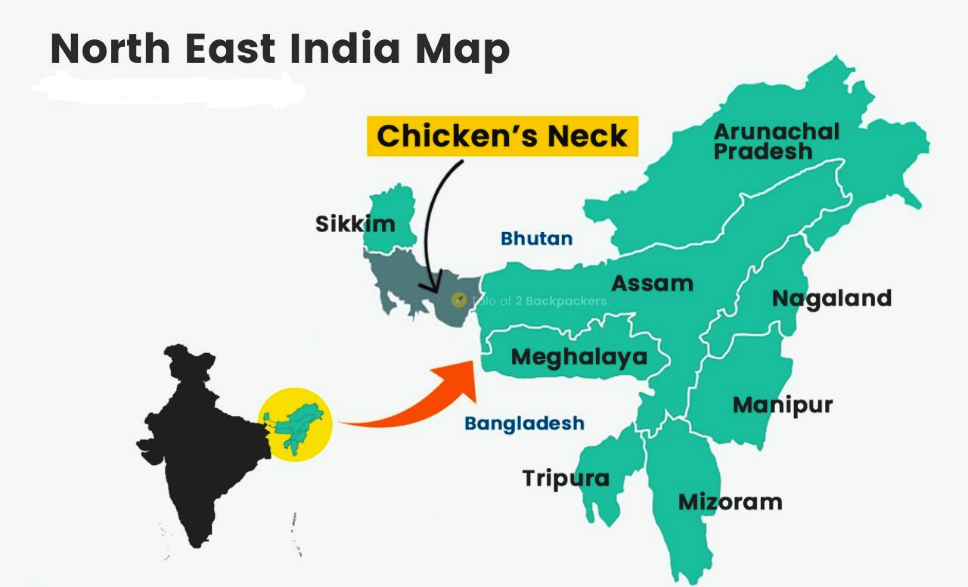Contents:
1. Statehood day of Tripura, Meghalaya and Manipur
2. Holding of simultaneous elections in the country
Statehood day of Tripura, Meghalaya and Manipur
Focus: GS I: Post-independence consolidation and reorganization within the country.
Why in News?
The Prime Minister of India congratulated the people of Tripura, Meghalaya and Manipur on their 52nd statehood day. On 21st January, 1972, all the three states became full-fledged states under the North Eastern Region (Reorganisation) Act, 1971. Therefore, the Statehood Day of Meghalaya is celebrated on January 21st every year.

Statehood Day is celebrated in India to commemorate the day when a particular state was officially recognized as a separate state of the Indian Union.
About Meghalaya:
- Capital: Shillong
- It is bounded on the north by Goalpara, Kamrup and Nowgong districts, on the east by Karbi Anglong and North Cachar Hills districts, all of Assam, and on the south and west by Bangladesh.
- It is predominantly inhabited by the Khasis, the Jaintias, and the Garo tribal communities.
- The Khasi Hills and Jaintia Hills, form the central and eastern part of Meghalaya.
- It is subject to the vagaries of the monsoon.
About Tripura:
- Capital: Agartala
- It shares borders with Bangladesh, Mizoram and Assam.
- The state is connected with the rest of India by NH-44 that runs through Assam, Meghalaya, North Bengal, Kolkata and other parts of India
- The social composition of the population of Tripura is diverse.
- Around one-third of the population belongs to the Scheduled Tribes.
About Manipur:
- Capital: Imphal
- It means “A jeweled land” nestled deep within a lush green corner of Eastern India.
- The state shares borders with other northeast states like Nagaland, Mizoram and Assam as well as with the neighbouring country of Myanmar.
- The then Governor-General of India Lord Irwin on his visit, described ‘Manipur as the Switzerland of the East.
- Its rich culture excels in every aspect as in martial arts, dance, theatre and sculptor
- Manipur hills are inhabited mainly by the Nagas, Kukis (Chin-Mizos)and smaller tribal communities and the valley are mainly by the Meiteis (including Meitei Muslims known as Meitei Pangal or Pangal and “Bhamons” who are non-Meiteis).
- Some Naga and Kuki settlements are also found in the valley region.
Holding of simultaneous elections in the country
Focus: GS2- Government Policies And Intervention
Why in News?
The High-Level Committee constituted by the Government under the Chairmanship of Shri Ram Nath Kovind former President of India to examine the issue relating to holding of simultaneous elections in the country and make recommendations thereon held its third meeting in New Delhi recently.
Simultaneous elections: The idea of holding simultaneous elections involves conducting elections for the Lok Sabha (the lower house of Parliament) and all state legislative assemblies at the same time. This is in contrast to the current practice where elections are held at different times for the Lok Sabha and various state assemblies, leading to frequent elections and associated challenges.
Advantages of Simultaneous Elections:
- Governance and consistency:
- Instead of constantly campaigning, the ruling parties will be able to focus on legislation and governance.
- Parties and workers who spend too much time and money on electioneering can use the time for social work and outreach to the grassroots.
- Overcoming the “policy paralysis and governance deficit” caused by the imposition of the Model Code of Conduct during election season, which halts all developmental activities in that area and has an impact on the bureaucracy’s functioning.
- Reduced Financial and Administrative Expenditure: o The entire State and District level administrative and security machinery will be preoccupied with the conduct of elections twice every five years, as is the current practise.
- Expenditure can be reduced by holding concurrent elections.
- It is believed that critical manpower is frequently deployed on election duties for an extended period of time. If elections are held concurrently, this manpower will be freed up for other important tasks.
- For example, the Central Armed Police Force deployed 1077 in situ companies and 1349 mobile companies for the 2014 Lok Sabha elections, which were held alongside four state assemblies (CAPF).
- Policy and programme continuity:
o Will limit the disruption to normal public life caused by elections, such as increased traffic and noise pollution.
- A large number of teachers are involved in the electoral process, which has the greatest impact on the education sector.
- Governance Efficiency:
o Simultaneous elections can bring much-needed operational efficiency to this exercise.
Government populist measures will be reduced.
- Curbs Vices:
- There is an increase in “vices” such as communalism, casteism, corruption, and crony capitalism during frequent elections.
- Simultaneous elections can also be used to combat corruption and create a more conducive socioeconomic environment.
- Because all elections are held at the same time, the impact of black money on voters will be reduced.
Problems with simultaneous elections:
- Illiteracy: Not all voters are well-educated enough to know who to vote for. They may become confused and not know whether they are voting for candidates running for assembly or parliament.
- According to an IDFC study, when elections are held concurrently, 77% of Indian voters will vote for the same party at the state and national levels.
- Evidence from Brazil, Argentina, Canada, Germany, the United States, and Europe supports the idea that simultaneous elections produce greater alignment between national and regional election outcomes.
- Functional issues:
o Frequent elections reconnect politicians with voters, create jobs, and prevent voters from confusing local and national issues.
- There aren’t enough security and administrative personnel to hold simultaneous free and fair elections across the country.
Conclusion:
The idea of holding simultaneous election is gaining traction. However, its implementation requires thorough deliberation to address constitutional, federal, and logistical considerations.
The concept, if executed thoughtfully, could lead to increased efficiency and enhanced governance in the Indian electoral system.





